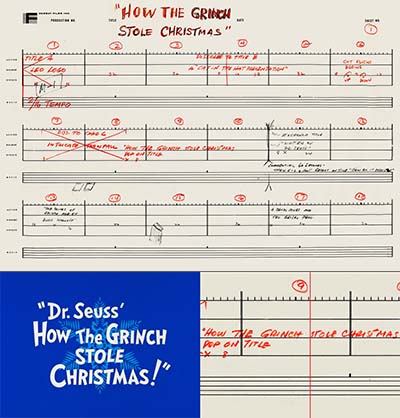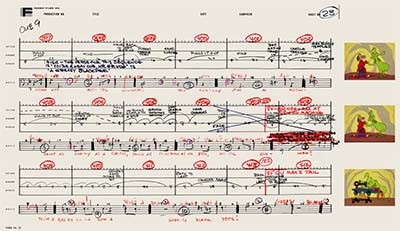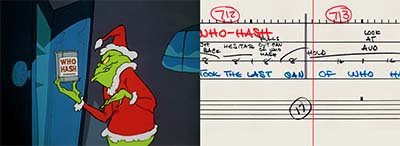
Members Only Download
Every other month, members of Animation Resources are given access to an exclusive Members Only Reference Pack. These downloadable files are high resolution e-books on a variety of educational subjects and rare cartoons from the collection of Animation Resources in DVD quality. Our current Reference Pack has just been released. If you are a member, click through the link to access the MEMBERS ONLY DOWNLOAD PAGE. If you aren’t a member yet, please JOIN ANIMATION RESOURCES. It’s well worth it.
MEMBERS LOGIN To Download Video
JOIN TODAY To Access Members Only Content
PDF E-BOOK / HD Video / Podcast

Chuck Jones Bar Sheets![]()
“How The Grinch Stole Christmas” (1966)
Animation Resources is proud to share with its members our most ambitious project to date— an e-book, video and podcast detailing the timing techniques used to make the Chuck Jones television special “How The Grinch Stole Christmas”. Chuck Jones was a master at controlling the pacing of the action for every single frame of his films. The method of timing cartoons in the golden age of animation is nothing like the way it is done today. We think you will learn a lot from this research, and perhaps discover some techniques to improve the timing of your own projects.
MUSICAL TIMING
One of the biggest mysteries about the way cartoons were made in the classic era is musical timing. The number of frames an action would take to perform was planned along with the music that would accompany the movement. This synergy of timing and music is a big part of why golden age cartoons are so much more rhythmic and synchronized than modern animation. The tool the director used to plan the timing of the action was the bar sheet. Every action was charted to follow a musical beat and structure right alongside the music composed to accompany it. Bar sheets ensured that the pacing was flexible, making it easy to accordion the timing in or out to accommodate specific overall running times. The accents in the animation were designed to fall in line with the musical form of beats, bars and measures. And if the action played a little bit too fast or too slow, it still felt correct when it was viewed because it matched the beat of the music. This allowed for maximum flexibility, and complete control over how the music and action were synchronized. With the advent of television and computers the process of timing animation has changed, and today the generation who knew how to time to a beat have long since retired or passed away. Musical timing has essentially become extinct.
In the mid 1970s, Chuck Jones visited the UCLA film school to speak to the students there. He made a gift of a batch of production material to Dan McLaughlin, the head of the animation department, to use in his curriculum. Included with this collection were the bar sheets for “Grinch”. Dan passed away last year, and his successor at UCLA, Doug Ward was charged with inventorying and finding a home for Dan’s collection of research materials. Doug is a member of Animation Resources, and was familiar with our previous research into musical timing, so he arranged to have the bar sheets donated to us for use in this project.

![]() For the past six months, animator Davey Jarrell and Animation Resources President Stephen Worth have been formatting, breaking down and analyzing Chuck Jones’s bar sheets to reverse engineer the secrets of musical timing. The result of this research is now available for members to download. First of all, we have produced a PDF e-book, with high resolution scans of the bar sheets themselves. Covered with notes by the musical director of “Grinch”, Eugene Poddanny, and action notes by Chuck Jones, this document details the first pass of planning for how the storyboard should be edited to time; and it outlined the basic structure of the featured songs and underscore. Also included is a widescreen video which sets the finished animation right next to a scrolling timeline of the bar sheet notes. You can still frame through the video and count frames and see exactly how the planning formed the foundation for the final film. Lastly, Davey Jarrell and Stephen Worth have recorded an hour long audio podcast, where they explain in detail how the process worked and what we can take from it to inform modern day animation technique.
For the past six months, animator Davey Jarrell and Animation Resources President Stephen Worth have been formatting, breaking down and analyzing Chuck Jones’s bar sheets to reverse engineer the secrets of musical timing. The result of this research is now available for members to download. First of all, we have produced a PDF e-book, with high resolution scans of the bar sheets themselves. Covered with notes by the musical director of “Grinch”, Eugene Poddanny, and action notes by Chuck Jones, this document details the first pass of planning for how the storyboard should be edited to time; and it outlined the basic structure of the featured songs and underscore. Also included is a widescreen video which sets the finished animation right next to a scrolling timeline of the bar sheet notes. You can still frame through the video and count frames and see exactly how the planning formed the foundation for the final film. Lastly, Davey Jarrell and Stephen Worth have recorded an hour long audio podcast, where they explain in detail how the process worked and what we can take from it to inform modern day animation technique.
We understand that the material we are presenting here is quite dense and technical. It may not all sink in on your first perusal. We encourage you to download and save this e-book, video and podcast, and archive it all on your hard drive, so you can absorb it at your leisure. The research is still ongoing and if you discover things in here that we may have missed, please let us know so we can share your discoveries with our members. It would be fantastic if today’s animators could learn from the example set by great directors of the past like Chuck Jones. Building on a solid foundation like that is what is needed to take modern animation to a new level.
Animation Resources would like to thank Doug Ward and the family of Dan McLaughlin for sharing this important set of documents with us.
MP3 Audio File / 58:13 / 70 MB Download
MEMBERS LOGIN To Download Video
JOIN TODAY To Access Members Only Content
MEMBERS LOGIN To Download Video
JOIN TODAY To Access Members Only Content
Not A Member Yet? Want A Free Sample?
Check out this SAMPLE REFERENCE PACK! It will give you a taste of what Animation Resources members get to download every other month!


































